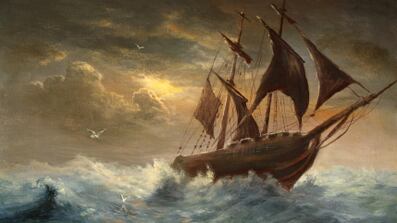
Read an excerpt from Ed Kritzler’s Jewish Pirates of the Caribbean, which reveals an unknown chapter in buccaneer lore—the saga of the Iberian Jews who escaped the Spanish Inquisition, set sail for treasure, and seized a New World colony.
At the dawn of the Age of Discovery when Spain’s monarchs banished them to purify and thereby unite their nation, followers of the Law of Moses sailed with the explorers and marched with the conquistadors. With the discovery and settlement of the New World, they took solace in the hope of finding there a haven, or at least putting distance between themselves and the Holy Terror. Unlike other pioneers, they had no “home” to return to and were among the first foreigners to permanently settle the New World. Going about as bona fide Christians, most carried their secret to the grave. The adventures of some who didn’t paint an extraordinary tableau of their time. They include the first Jew burned in the New World and others, men and women, who joined in the conquest of Mexico.
It made no difference if one was a true convert, an atheist, or a covert Jew. All were subject to prosecution.
Heretic Conquistador
Hernando Alonso had it made. Six short years after serving with Cortez as a carpenter’s assistant, “hammering nails into the brigantines used in the recapture of Mexico,” he had become the richest farmer in the new Spanish colony. While most soldiers of his rank received nothing more from the conquest than “the cost of a new crossbow,” Alonso was awarded a large tract of land north of Mexico City. Turning it into a pig and cattle farm, Alonso became the biggest supplier of meat to the colony.
In September, 1528, it was reported that Alonso, now 36, and getting as portly as his beef in emulation of his commander, “swaggered about in a belt of refined gold he had exacted from the natives.” He had good reason: In March, his contract to supply meat to the colony had been renewed by Cortez himself and he had taken a new wife, the “very beautiful” Isabel de Aguilar.
This information on Hernando Alonso comes from the trial records of the Spanish Inquisition. On 17 October 1528, Alonso became the first person in the New World to be burned alive at the stake. Alonso was a Jew, a secret Jew, as was his deceased first wife Beatriz, the sister of Diego Ordaz, one of Cortez’ five captains. His undoing came when a Dominican friar charged that years before in Santo Domingo he had secretly observed Alonso and Beatriz, following their son’s baptismal ceremony, “washing the boy’s head with wine to cleanse him of the Holy Water.” When threatened with torture, Alonso confessed that after the wine ran down the child’s body and “dripped from his organ,” he caught it in a cup and drank it “in mockery of the sacrament of baptism.”
Cortez had no part in the arrest of Alonso. After approving Alonso’s contract, he left for Spain to answer trumped-up charges of misrule. In his absence, a rival faction in the colony conspired with the powers of the Inquisition and introduced the “Holy Terror” to the New World. The holier-than-thou Inquisitors who considered Aztecs savages for sacrificing prisoners to their gods atop their Great Pyramid chose the plaza fronting the site, where a lofty edifice of the True Church had replaced the pyramid, to consign the heretic to the flames.
In a time of carefully arranged marriages, Hernando Alonso would not have married Beatriz Ordaz without the blessing of her brother. Diego Ordaz, one of the outstanding figures of the Conquest, was the first man to climb the volcano Popocatepetl and look upon the Valley of Mexico. Mesmerized by what seemed to be a floating city, he compared it to a vision out of the chivalric tale Amadis de Gaul, the sword and sorcerer book of the time.
Before joining up with Cortez, Alonso and Diego were in Cuba but on far different rungs of society. Alonso was a blacksmith in town, while Diego and his sisters lived in the governor’s mansion, where he served as majordormo. Despite this all-important class difference, Beatriz married the blacksmith. Apparently decisive was the one thing they did share, a common ancestry. Cortez’ captain wound up his days gathering pearls off the Venezuela coast, only to be poisoned by rivals in 1532. Although much is written about him, nowhere is it mentioned that he was a converso, much less a secret Jew. Like most conversos, Diego passed himself off an Old Christian, and went to his grave with his masquerade intact.
New World Jewesses
Senoritas were a rarity throughout the New World. With less than one Spanish woman for every 10 men, to marry one was considered a feather in the cap for the mostly poor, aspiring hidalgos. After Mexico’s conquest, some ladies felt the same about them. Most were servant girls who journeyed to New Spain to find themselves a newly rich husband. Exceptions were the four daughters of the royal treasurer Alonso Estrada, the natural son, or so he claimed, of King Ferdinand. Few women were as desirable as the Estrada sisters, who could choose from among many suitors, and it is therefore not surprising that they all married well. What is surprising is that their mother was from a well-known Jewish family and their husbands would have known of their wives’ blemished ancestry. That their progeny would also be stigmatized seems not to have mattered. Despite the aggressiveness of the Holy Fathers, and repeated decrees against conversos (converted Jews), they were able to keep their wives’ and children’s Jewish heritage secret. The same holds true of Beatriz and Diego Ordaz’s surviving sister. Only now is their story being reported.
Francisca Ordaz
As Beatriz, having accompanied her husband, lay dying during the siege of Mexico, her sister Francisca was by her side. The two were among only six Spanish women known to have accompanied the conquistadors during the fighting in Mexico. After the final victory, Francisca was observed enjoying a wild night of celebration. According to an eyewitness, Francisca and three other “adventurous women went gaily to dance with men still in their quilted armor.” It may well have been that night that she danced with her future husband, the son of Ponce de Leon, one of the legendary figures of the New World.
After Alonso’s undoing, Diego Ordaz was not about to fix up Francisca with another covert Jew. Instead he found Juan Gonzalez Ponce de Leon, a valiant suitor of noble, unblemished credentials. His father, the conqueror and governor of Puerto Rico, and discoverer of Florida, is forever known for what he searched for when he was getting old—the Fountain of Youth. His son was distinguished in his own right. Serving as a soldier under Ordaz’ command, Juan was the first man to reach the top of the main temple of Tenochtitlan and, despite being badly wounded, led a vanguard force that captured Montezuma. When Cortez asked him why, considering his injury, he had not withdrawn, but instead led the fight up the steps to Montezuma’s quarters, Juan answered: “Senor, this is not the time for men to be in bed.”
Juan was aware of Francisca lineage even before Alonso’s trial had exposed her sister as a judaizer (a false converso). For years he and Alonso were friends, and until Alonso’s flaming death the two men were partners. They shared an encomienda in Actopan in the modern state of Hidalgo, about 60 miles north of Mexico City, where Alonso had his farm.
Alonso Estrada’s Wife & Daughters
In 1522, King Charles V appointed his alleged uncle Alonso Estrada as the colony’s royal treasurer, perhaps the most important position in the rich territory. It was a common belief he was the bastard son of King Ferdinand, the result of a liaison with Donna Luisa de Estrada, the daughter of Don Fernan, Duke of Aragon, when both were teenagers. Raised in Ferdinand’s court, Alonso inherited the title Duke of Aragon and sided with Charles V when he was contending for the Crown. While some Internet postings speculate that he had Jewish ancestors, his wife certainly did. It was widely known that Marina Gutierrez Flores de la Caballeria was from an old Jewish family whose wealth has been compared to the Rothschilds'. Although both sides of her family had converted to Catholicism, for three generations they were condemned as judaizers. Donna Marina, having secured a forged affidavit attesting to her pure blood, followed her husband to Mexico.
Following his death in 1531, she cemented her place in colonial society by marrying off her daughters to two of Mexico’s prominent conquistadors. The youngest, Beatrice Estrada, married Vasquez de Coronado, who (with his wife’s money) set off to find the fabled seven Golden Cities of Cibola. Although the object of his search never was, in the process Coronado was the first to explore America’s Southwest and discovered the Grand Canyon. Luisa, the oldest, became the wife of Jorge de Alvarado, a conqueror of Mexico and governor of Guatemala. The two other Estrada sisters likewise married nobility. What do these marriages portend? Since the Jewish ancestry of their mother-in-law was known, and that her Old Christian certification was a sham, it apparently did not overly concern them that their children would no longer be of pure blood.
In the first four decades of the Age of Discovery, known conversos were involved in nearly every venture as explorers, pilots, and conquistadors or behind the scenes as financiers, ship owners, and administrators. Since all Spanish conversos were forbidden in the New World, it made no difference if one was a true convert, an atheist, or a covert Jew. All were there illegally and therefore subject to prosecution. Today with the advent of Sephardi websites, the Jewish roots of other early pioneers are being disclosed in postings by their descendants. They include the first cowboys in America, but that is another story for another time.
Edward Kritzler is a historian and a former New York-based reporter. He lives in Kingston, Jamaica. He is the author of Jewish Pirates of the Caribbean (Doubleday)






